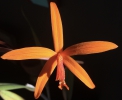|
|
|
|
|
| |
Established Seedlings of
Laelia cinnabarina 'MC7472' × self |
|
| |
|
|
| |
| Number: |
TN8537 |
| Name: |
Laelia cinnabarina 'MC7472' × self
|
| Type: |
self (What's that?) |
|
Seed Donor: |
Damon Harris
|
|
Click to Enlarge

Pod Parent Flower |
|
|
|
| |
For additional origin/habitat information supplied courtesy of
Charles and Margaret Baker, see further below, near the bottom of this page.
|
Temperatures we attempt to use in the lab & greenhouse:
| For Species: |
|
Spring, Summer, Autumn: days average 73°F, nights 60°F; best fit is Cool-Intermediate 75-58°F
(Source:
Baker's Web OSC) |
| For Species: |
|
Winter: days average 67°F, nights 51°F; best fit is Cool 70-52°F
(Source:
Baker's Web OSC) |
|
About the name...
| Etymology of |
cinnabarina |
|
From Latin "cinnabarinus" vermilion.
(Source:
Mayr & Schmucker 1998) |
| Etymology of |
Laelia |
|
One of the vestal virgins, Laelia.
(Source:
Pridgeon 1992) |
| Pronunciation of |
Laelia |
|
LAY-lee-ah
(Source:
Pridgeon 1992) |
|
If you would like to direct someone to this web page, please copy and paste this URL into your email:
http://troymeyers.com/d?128537
|
ESTABLISHED SEEDLINGS
of these are not currently available, but we have some maturing in the greenhouse and expect to offer them in the future.
There are 4 items with
1 to 9 plants per
item
(2 are
compots) that will be considered for sale later.
Click here to see if we have flasks available.
|
|
|
| |
The origin/habitat information below is supplied courtesy of Charles and Margaret Baker
The following information is based on the name of the plant provided by the donor, and assumes that the name is correct. If the plant has been misidentified, then the following information may not be correct.
This text is copyrighted by the Bakers and may not be reproduced without permission.
ORIGIN/HABITAT: Brazil. Laelia cinnabarina is a large species from
southern Minas Gerais and the northern parts of the adjacent states of Rio
de Janeiro and São Paulo. Plants grow on rocky slopes, often with their
roots extending down into crevices in the rock. They grow amid tall
grasses and shrubby vegetation at 2300–4900 ft. (700–1500 m).
More about this information and the Bakers...
|
|
|
| |
|
|
|